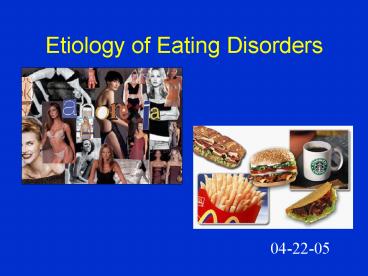Etiology of Eating Disorders - PowerPoint PPT Presentation
1 / 14
Title:
Etiology of Eating Disorders
Description:
Genetic influences: May be a shared familial risk factor for anorexia & bulimia ... Treatments are similar for Bulimia and BED, but may include weight loss for BED ... – PowerPoint PPT presentation
Number of Views:151
Avg rating:3.0/5.0
Title: Etiology of Eating Disorders
1
Etiology of Eating Disorders
04-22-05
2
Societal Influences
- Thin ideal for females
- Lean, muscular ideal for males
- Media TV, Internet, magazines
- Distorted images Toys (e.g., Barbie)
- Sex differences in physical ideal
- Toxic environment encourages overeating of
unhealthy foods physical inactivity (Brownell)
3
(No Transcript)
4
Model of Eating Disorders
Pressure to be thin
Dieting
Body dissatisfaction
Eating disorders
Thin-ideal internalization
Negative affect
Adapted from Stice (2001)
5
Family Peer Influences
- Psychodynamic theory Anorexia stems from a fear
of growing up and having to separate from family,
develop identity - Family systems (Minuchin) Poor family
communication characterized by parental control,
emotional enmeshment, conflicts not openly
expressed leads to anorexia
6
Family Peer Influences
- Stice Bearman (2001) Peers and family produce
pressure to be thin. - Criticism of weight and body shape, encouragement
to diet, glorification of ultra-slim models - Along with the media, this helps create
internalization of thin ideal body image.
7
Cultural Factors
- Eating disorders are found primarily in Western
cultures (e.g., U.S., Europe) - Few reports of eating disorders in Latin America
and Asia - Exposure to Western culture is associated with
increased concern over body shape eating - African American women show less weight concern,
and higher body and appearance satisfaction than
white counter-parts, although they tend to be
heavier
8
Protective Factors
- African American women do not identify with white
women, so media messages of thin ideal have less
impact - African American definition of attractiveness is
broad, includes style of dress, personality, and
confidence - African American have assertive and egalitarian
roles in community less influenced by
gender-restrictive messages
9
Chenese Lewis, Miss Plus America
Ambassador, Model/Actress
10
But internalization of U.S. societal values
regarding thinness is a risk factor for eating
disorders among women of color.
And some African American women are at risk for
eating disorders, especially BED.
http//www.cytoys.com/details.asp?id1054
11
Other Possible Factors
- Personality Perfectionism
- Negative affect/depression
- Lack of empirical support for sexual abuse as a
causal factor - Genetic influences May be a shared familial risk
factor for anorexia bulimia - Twin study of bulimia MZ 23, DZ 9 (Kendler
et al., 1991)
12
Treatment for Anorexia
- Treatments teach clients to identify impact of
societal messages re thinness develop
healthier goals - Both medical and psychological treatment is
needed because body is starving - Goals 1) gain weight, 2) normalize eating
patterns, 3) understand alter thoughts related
to body image, 4) develop healthier coping for
stress - Behavioral approaches use positive reinforcers to
reward weight gain
13
Treatment for Bulimia
- Treatments teach clients to identify impact of
societal messages re thinness develop
healthier goals - Medical treatment may be needed because of
problems due to purging - Goals 1) normalize eating pattern, 2) eliminate
binge-purge cycle - Cognitive-behavioral therapy, interpersonal
therapy, and anti-depressant medication
14
CBT for Bulimia BED
- Treatments are similar for Bulimia and BED, but
may include weight loss for BED - Identify cognitive factors underlying disorder
(i.e., triggers) - Cognitive strategies are used to challenge
distorted beliefs about eating - Healthy pattern of eating, food diaries, weekly
weighing, nutrition exercise info - Relapse prevention for potential setbacks































